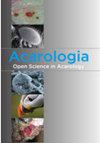首次了解陆地甲螨跗爪的形态发育
IF 1.1
3区 农林科学
Q3 ENTOMOLOGY
引用次数: 1
摘要
螨类占据着广泛的生态位,是研究节肢动物形态结构与生态学相关性的良好模型。在这里,我们比较了三种不同生态背景的陆地甲螨的跗爪形状。通过几何形态计量学的方法,我们描述了单趾螨Lamellotox caelatus和Platynotrus peltifer以及南方黑藻Tridacyl Melanozetes meridianus的跗爪的形状、大小和发育。经过对幼螨和成年螨的分析,我们可以区分爪弯曲度相似的广食性盾叶螨和高山子午纹螨,以及爪弯曲度明显较小的萨克斯库洛斯盾叶螨。另一方面,盾叶虎的爪高显著高于其他两个物种。尽管存在这些差异,但无法推断出爪子特征与环境因素之间的相关性。在螨的发育过程中,从原若虫到成虫,爪的弯曲度和形状保持不变,爪的大小与所有研究物种的身体生长成正比。单趾和三趾物种的爪特征都没有任何特定的变化。本文章由计算机程序翻译,如有差异,请以英文原文为准。
First insights into the morphological development of tarsal claws in terrestrial oribatid mites
Mites occupy a wide range of ecological niches and are good models to investigate correlations of morphological structures and ecology in arthropods. Here we compare tarsal claw shape of three terrestrial oribatid mite species with different ecological backgrounds. By means of geometric morphometrics we describe shape, size and development of the tarsal claw of the monodactyl mite species Lamellovertex caelatus and Platynothrus peltifer, and the tridactyl Melanozetes meridianus. After analysis of juvenile and adult mites we can distinguish the euryoecious P. peltifer and the alpine M. meridianus with similar claw curvatures from the saxicolous L. caelatus with considerably less curved claws. The claw height of P. peltifer, on the other hand, is remarkably higher than in the other two species. Despite these differences, no correlation between claw characteristics and environmental factors can be inferred. During the development of the mites, claw curvature and shape remain constant from protonymph to adult and claw size increases direct proportionally with body growth in all studied species. Neither the monodactyl nor the tridactyl species show any specific changes in claw characteristics.
求助全文
通过发布文献求助,成功后即可免费获取论文全文。
去求助
来源期刊

Acarologia
ENTOMOLOGY-
CiteScore
2.00
自引率
18.20%
发文量
81
期刊介绍:
Acarologia is a free open-access journal. Please help us by submitting manuscripts in accordance with following instructions.
All manuscripts which do not conform to the instructions will be returned to authors without the benefit of review.
Acarologia publishes the results of original research on all aspects of Acarology.
The journal policy is that taxonomic descriptions should include several species within a same genus/family, when possible.
The editors reserve the right to refuse manuscripts when authors intentionally divide individual species descriptions of the same genus/family into distinct publications.
Single species descriptions should be clearly justified based on their scientific interest.
 求助内容:
求助内容: 应助结果提醒方式:
应助结果提醒方式:


